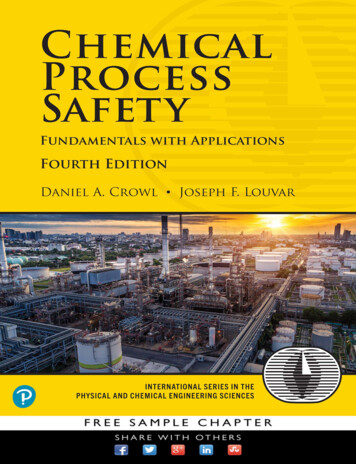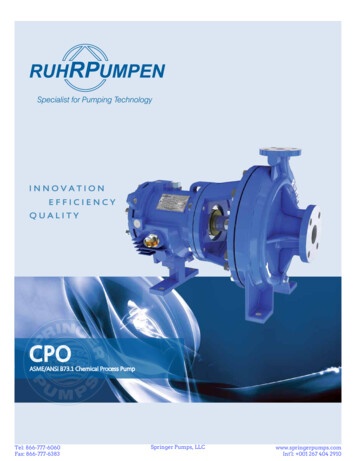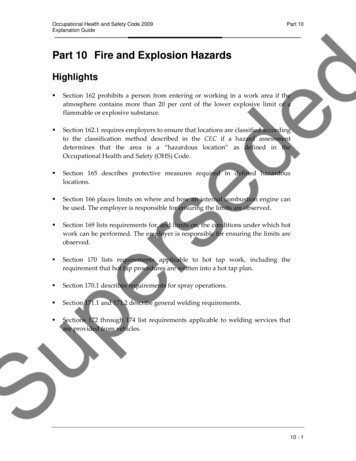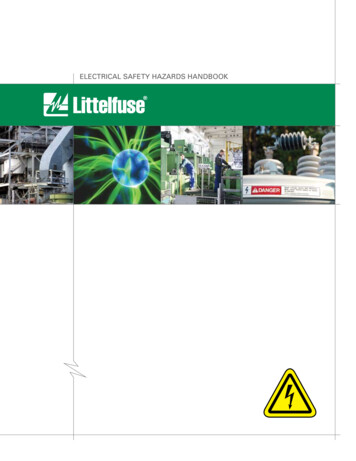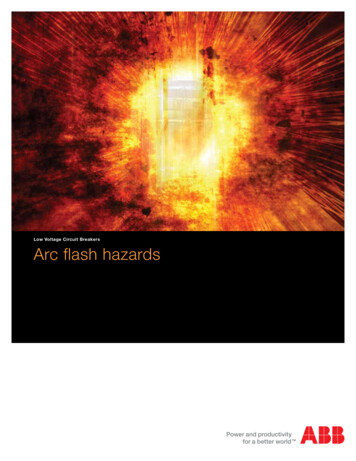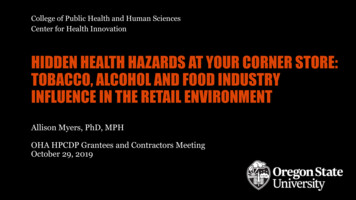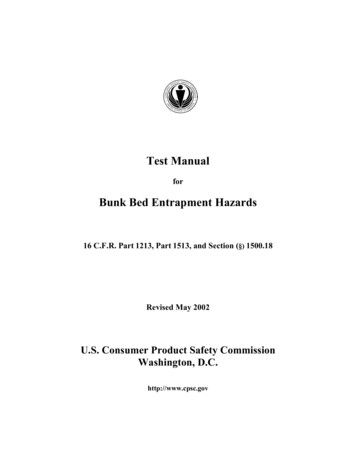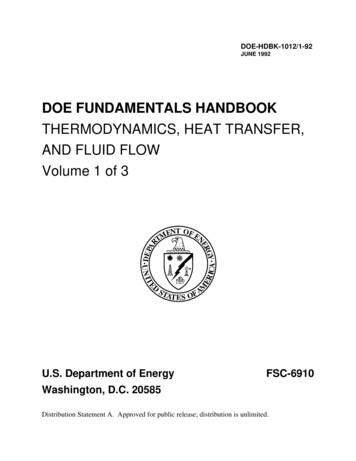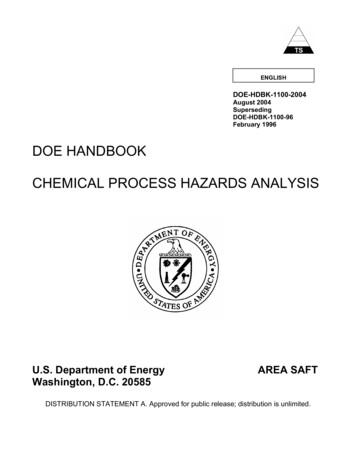
Transcription
ENGLISHDOE-HDBK-1100-2004August 2004SupersedingDOE-HDBK-1100-96February 1996DOE HANDBOOKCHEMICAL PROCESS HAZARDS ANALYSISU.S. Department of EnergyWashington, D.C. 20585AREA SAFTDISTRIBUTION STATEMENT A. Approved for public release; distribution is unlimited.
This document has been reproduced directly from the best available copy.Available to DOE and DOE contractors from the ES&H Technical Information Services, U.S. Departmentof Energy, (800) 473-4375, fax: (301) 903-9823.Available to the public from the U.S. Department of Commerce, TechnologyAdministration, National Technical Information Service, Springfield, VA 22161;(703) 605-6000.
DOE-HDBK-1100-2004FOREWORDThe Office of Health (EH-5) under the Assistant Secretary for the Environment, Safety andHealth of the U.S. Department of Energy (DOE) has published two handbooks for use by DOEcontractors managing facilities and processes covered by the Occupational Safety and HealthAdministration (OSHA) Rule for Process Safety Management of Highly Hazardous Chemicals(29 CFR 1910.119), herein referred to as the PSM Rule. The PSM Rule contains an integratedset of chemical process safety management elements designed to prevent chemical releases thatcan lead to catastrophic fires, explosions, or toxic exposures. The purpose of the twohandbooks, "Process Safety Management for Highly Hazardous Chemicals" and "ChemicalProcess Hazards Analysis," is to facilitate implementation of the provisions of the PSM Rulewithin the DOE.The purpose of this handbook is to facilitate, within the DOE, the performance of chemicalprocess hazards analyses (PrHAs) as required under the PSM Rule. It provides basicinformation for the performance of PrHAs, and should not be considered a complete resource onPrHA methods. Likewise, to determine if a facility is covered by the PSM rule, the readershould refer to the handbook, "Process Safety Management for Highly Hazardous Chemicals"(DOE-HDBK-1101-2004).Promulgation of the PSM Rule has heightened the awareness of chemical safety managementissues whithin the DOE. This handbook is intended for use by DOE facilities and processescovered by the PSM rule to facilitate contractor implementation of the PrHA element of thePSM Rule. However, contractors whose facilities and processes not covered by the PSM Rulemay also use this handbook as a basis for conducting process hazards analyses as part of theirgood management practices.This handbook explains the minimum requirements for PrHAs outlined in the PSM Rule.Nowhere have requirements been added beyond what is specifically required by the rule.iii
DOE-HDBK-1100-2004ACKNOWLEDGEMENTSThe U.S. Department of Energy (DOE) wishes to thank all persons who commented on thishandbook for their help in clarifying and focusing this guidance. Ms. Pamela Sutherland ofBattelle-Columbus managed the preparation of this handbook by Battelle Memorial Institutestaff in Columbus and at Pacific Northwest Laboratories (PNL).iv
DOE-HDBK-1100-2004TABLE OF CONTENTSPageFOREWORD.iiiACKNOWLEDGEMENTS . ivLIST OF TABLES .viiLIST OF FIGURES.viiiACRONYMS . ixGLOSSARY . x1.0 INTRODUCTION. 12.0 OVERVIEW OF REQUIREMENTS FOR PROCESS HAZARD ANALYSISUNDER THE PSM RULE . 32.1Process Safety Information. 32.2Process Hazard Analysis . 43.0 ESSENTIAL ELEMENTS OF PROCESS HAZARD ANALYSIS . 73.1Step-by-Step Procedure . 73.2Elements Common To All Process Hazard Analyses . 113.3Presentation of Results . 224.0 PROCESS HAZARD ANALYSIS METHODS WITH EXAMPLES .4.1Checklist Analysis .4.2What-If Analysis .4.3What-If/Checklist Analysis .4.4Hazard and Operability Study .4.5Failure Mode and Effects Analysis .4.6Fault Tree Analysis .232330364452595.0 REPORTING AND REVIEW OF ANALYSES . 665.1Reporting the Process Hazard Analysis . 665.2Review of the Process Hazard Analysis. 686.0 ESTABLISHING A SYSTEM FOR RESOLVING ACTION ITEMSAND IMPLEMENTING CORRECTIVE ACTIONS .6.1Process Hazard Analysis Action Items and Recommendations .6.2Criteria for Corrective Actions and Safety Improvements.6.3The Corrective Actions System.v71717172
DOE-HDBK-1100-20047.0 UPDATING THE PROCESS HAZARD ANALYSIS .7.1Update Team .7.2Approach .7.3Documentation .737373738.0 RELATIONSHIPS OF PROCESS HAZARD ANALYSES TO OTHER DOEREQUIRED HAZARD ANALYSES . 749.0 REFERENCES . 76vi
DOE-HDBK-1100-2004LIST OF TABLESPageTable 3.1. Process Hazards.Table 3.2. Checklist for Worker Exposures .Table 3.3. Checklist of Facility Siting Issues .Table 3.4. Example Human Factors in Process Operations .Table 4.1. Simplified Process Hazards Analysis Checklist.Table 4.2. Main Headings of Well's Checklist.Table 4.3. Main Headings of Baleman's Checklist .Table 4.4. Approximate Checklist Analysis Time Requirements .Table 4.5. Checklist Analysis of Dock 8 HF Supply System.Table 4.6. Checklist Analysis of Cooling Water Chlorination System.Table 4.7. Typical Format for a What-If Analysis Worksheet.Table 4.8. Approximate Time Requirements for What-If Analyses .Table 4.9. What-If Analysis of Dock 8 HF Supply System .Table 4.10. What-If Analysis of Cooling Water Chlorination System .Table 4.11. Approximate What-If/Checklist Analysis Time Requirements .Table 4.12. What-If/Checklist Analysis of Dock 8 HF Supply System.Table 4.13. What-If/Checklist Analysis of Cooling Water Chlorination System .Table 4.14. Guide Words for HAZOP Studies.Table 4.15. Example HAZOP Study Process Parameters and Deviations .Table 4.16. Typical Format for a HAZOP Study Worksheet.Table 4.17. Time Estimates for Using the HAZOP Study Method.Table 4.18. Example HAZOP Study for the Dock 8 HF Supply System.Table 4.19. Example HAZOP Study for the Cooling Water Chlorination System.Table 4.20. Example FMEA Worksheet .Table 4.21. Time Estimates for Using the Failure Mode and Effects Analysis Method.Table 4.22. Partial FMEA for the Dock 8 HF Supply System .Table 4.23. Partial FMEA for the Cooling Water Chlorination System .Table 4.24. Fault Tree Symbols .Table 4.25. Minimal Cutset Documentation .Table 4.26. Time Estimates for Using the Fault Tree Analysis Method.Table 5.1. Deviations 950515657585961636369
DOE-HDBK-1100-2004LIST OF FIGURESPageFigure 3.1.Figure 3.2.Figure 3.3.Figure 4.1.Figure 4.2.Figure 4.3.Figure 4.4.Process Hazard Analysis Task Structure . 9Example Interaction Matrix for Identifying Process Hazards . 15Anatomy of an Accident . 17Dock 8 HF Supply System. 24Cooling Water Chlorination System . 25Example FTA for the Dock 8 HF Supply System . 64Example FTA for the Cooling Water Chlorination System. 65viii
HISOPTLVTQUFLAmerican National Standards InstituteAmerican Petroleum InstituteAmerican Society of Mechanical EngineersAmerican Society for Testing and MaterialsCenter for Chemical Process SafetyU.S. Department of EnergyU.S. Department of TransportationEmergency Response Planning GuidelineEquilibrium Vapor ConcentrationFault Tree Analysis ProgramFailure Mode and Effects AnalysisHazard and OperabilityHighly Hazardous ChemicalImmediately Dangerous to Life or HealthIntegrated Reliability and Risk Analysis SystemInstitute of Electrical and Electronic EngineersInstrument Society of AmericaJob Hazard AnalysisLower Flammability LimitManagement and OperationMinimal Cut SetManagement of ChangeMaterial Safety Data SheetNational Fire Protection AssociationOrganization Resources CounselorsOperational Readiness ReviewOccupational Safety and Health AdministrationPiping and Instrumentation DiagramPermissible Exposure LimitPreliminary Hazards AnalysisProcess Hazard AnalysisProcess Safety InformationProcess Safety ManagementPre-Startup Safety ReviewSafety Analysis ReportSubstance Hazard IndexStandard Operating ProcedureThreshold Limit ValueThreshold QuantityUpper Flammability Limitix
DOE-HDBK-1100-2004GLOSSARYAccident, Accident Event SequenceAn unplanned event or sequence of events that has an undesirable consequence.Aggregate Threshold QuantityThe total amount of a hazardous chemical contained in vessels that are interconnected, orcontained in a process and nearby unconnected vessels, that may be adversely affected byan e
handbooks, "Process Safety Management for Highly Hazardous Chemicals" and "Chemical Process Hazards Analysis," is to facilitate implementation of the provisions of the PSM Rule within the DOE. The purpose of this handbook is to facilitate, within the DOE, the performance of chemical process hazards analyses (PrHAs) as required under the PSM Rule. It provides basic information for the .
